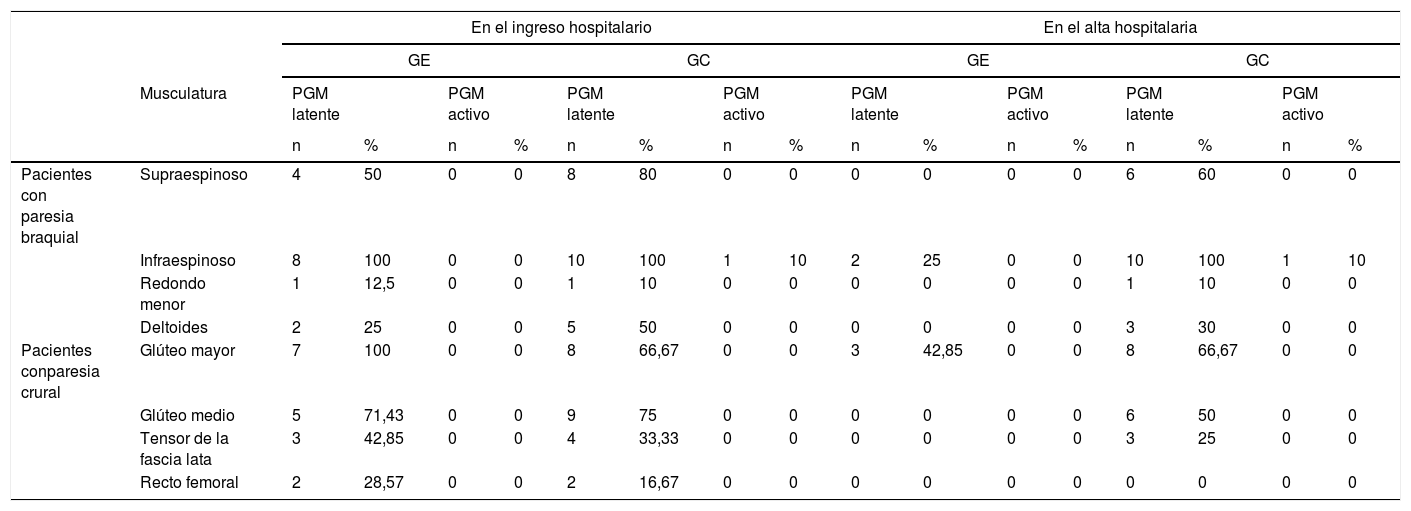Evaluar la influencia del tratamiento de los puntos gatillo miofasciales (PGM) en el balance motor y en la autonomía funcional en pacientes con ictus isquémico agudo.
Participantes y métodosSe incluyeron 22 pacientes con ictus isquémico de menos de cinco días de evolución, con paresia braquial y/o crural en un estudio piloto, aleatorizado, a doble ciego, de tratamiento experimental vs. control. Durante la hospitalización, ambos grupos recibieron la fisioterapia. Adicionalmente, al grupo experimental (GE) se le trataron los PGM detectados en hombro y cadera paréticos y al grupo control (GC) se le aplicó un tratamiento sin efectos sobre los PGM. Fueron registrados al alta y a los 90 días postictus el grado fuerza de las extremidades paréticas mediante la National Institute of Health Stroke Scale, y el grado de autonomía funcional mediante la escala de Rankin modificada.
ResultadosSe detectó una mejoría tanto en la fuerza de las extremidades paréticas (probabilidad al alta de un mejor balance motor del 75,6% en la extremidad superior y del 69% en la extremidad inferior), como en la autonomía funcional (probabilidad de una mejor funcionalidad del 68%) en el GE comparado con el GC. Estos resultados no se mantuvieron a los 90 días de seguimiento.
ConclusionesEl tratamiento de los PGM como complemento al tratamiento de fisioterapia durante el ingreso hospitalario parece mejorar el balance motor y el grado de autonomía funcional al alta. Son necesarios futuros estudios que permitan confirmar nuestros resultados y evaluar el beneficio de una intervención más allá del ingreso hospitalario.
To assess the influence of treatment of MTrPs on motor balance and functional autonomy in patients with acute ischaemic stroke.
Patients and methods22 patients with ischaemic stroke of less than 5 days’ evolution, with brachial and / or leg paresis were included in a randomized, double-blind, pilot study of experimental versus control treatment. During hospitalization, both groups received physiotherapy. In addition, the MTrPs detected in the paretic shoulder and hip were treated in the experimental group (EG). In contrast, the control group (CG) were given treatment without effects on the MTrPs. At the time of hospital discharge and 90 days post-stroke, we recorded the degree of strength of the paretic limbs using the National Institute of Health Stroke Scale, and the degree of functional autonomy using the modified Rankin Scale.
ResultsWe detected an improvement both in the strength of the paretic limbs (probability at discharge of a better motor balance of 75.6% in the upper limb and 69% in the lower limb) and in functional autonomy (68% probability of better functionality) in the EG compared to the CG. These results were not maintained at 90 days of follow-up.
ConclusionsTreatment of MTrPs as a complement to physiotherapy treatment during hospital admission seems to improve the degree of strength of paretic limbs and the degree of functional autonomy at hospital discharge. Future studies are necessary to confirm our results and evaluate the benefit of an intervention beyond hospital admission.
Article
Si ya tiene sus datos de acceso, clique aquí.
Si olvidó su clave de acceso puede recuperarla clicando aquí y seleccionando la opción "He olvidado mi contraseña".








